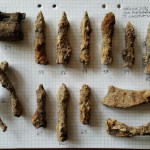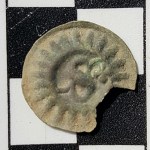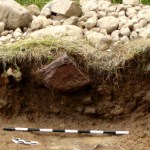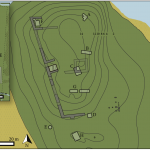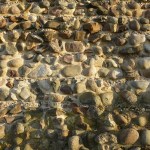Castles
Poppies along our fence
My wife receives her second university degree today. In addition to her 15 years in journalism, she is now also a trained psychologist. Go YuSie!!!
I assume 45's lawyers cleared the covfefe tweet?
Small but very satisfying discovery. In 1902 a Medieval coin is found at Skällvik Castle. The finder makes a detailed drawing of the coin and sends coin & drawing to the authorities, who promptly lose track of the coin. Gone. In 1954 a list is drawn up of twelve Medieval coins found at nearby Stegeborg Castle. In 1983 the list is published -- and suddenly there are…
Palaeobotanist Jennie Andersson has analysed four soil samples for me, all from floor layers inside buildings at Medieval strongholds that me and my team have excavated in recent years. There's one each from Stensö, Landsjö, Skällvik and Birgittas udde. Results were sadly not very informative.
Comments Jennie:
"Overall the fossil and carbonised botanical material in the samples, as well as the recent unburnt material, is meagre … No carbonised cereals were found. Three of the four samples did however contain rather large amounts of unburnt bones and scales from fish plus jurpa, a blanket term…
I'm writing an interdisciplinary book about lifestyles at Medieval strongholds in Östergötland province, Sweden. The central chapter "Activities and roles" is currently 8,900 words. Here are the section headers.
Agriculture at arm's length
Baking bread
Brewing
Animal husbandry and the eating of meat
Hunting and the eating of game and wildfowl
Fishing and the eating of fish
Cooking
Dining and drinking
Waste disposal
Relieving oneself
Lighting
Keeping warm
Healthcare and personal grooming
Fashion and jewellery
Ladyship
Chivalry and horsemanship
Love affairs
Weddings
Growing up
Religion
Music…
Supported by a grant from the King Gustavus Adolphus VI Foundation For Swedish Culture, osteologist Lena Nilsson has analysed the bones we collected during excavations last year at two Medieval strongholds. Two weeks with 19 fieldworkers at Birgittas udde produced only 0.4 kg of bones, because the site has no culture layers to speak of and the sandy ground has been unkind. But from the following two weeks at Skällvik Castle we brought home 32.7 kg of bones! And now Lena has looked at them all. Here are her reports:
Birgittas udde 2016
Skällvik Castle 2016
The reports are…
My detectorist friend and long-time collaborator Svante Tibell found a seal matrix in the field next to Skällvik Castle this past summer. In the Middle Ages of Sweden, people of means didn't sign their names to documents. They carried seals around, with which they made imprints into chalk-mixed wax, and these were affixed to paperwork such as property deeds and wills. If you lost your seal matrix, you lost your ability to sign documents – and you theoretically gave that ability to whoever found your seal. When people died during this period, their seal matrices were carefully destroyed.…
Our second week at Skällvik Castle proved a continued small-finds bonanza, and we also documented some pretty interesting stratigraphy.
More of everything in Building IV. In addition to more coins of Magnus Eriksson, dice and stoneware drinking vessels, we also found a lot of points for crossbow bolts. It's starting to look like the castle guards' day room! As for why we found crossbow bolts only inside one building and none outdoors in the bailey, I figure that they had been amassed there for re-fletching. The dark indoors find context and the undamaged sharp points show that the bolts did…
The famous royal castle of Stegeborg sits on its island like a cork in the bottleneck of the Slätbaken inlet (see map here). This waterway leads straight to Söderköping, a major Medieval town, and to the mouth of River Storån which would allow an invader to penetrate far into Östergötland Province's plains belt. The area's first big piece of public construction was 9th century fortifications intended to guard this entrypoint, in the shape of the Götavirke earthen rampart some ways inland and a wooden barrage at Stegeborg. This barrage was kept up for centuries, and indeed, the castle's name…
We spent Thursday afternoon backfilling. As I write this, only trench G remains open, and the guys there expect to finish soon. Here's some highlights of what we've learned during our second week at Birgittas udde.
Trench A in the outer moat demonstrated that the moat had a wide flat bottom, was not very deep and contains no lake sediments. Probably always a dry moat, providing material for the bank behind it. No Medieval finds.
Trench C: section through the deep inner moat.
Trench C in the inner moat demonstrated that this moat too had a wide flat bottom, but it was deeper and is full of…
Ulvåsa in Ekebyborna is a manor near Motala with two known major Medieval elite settlement sites. Excavations in 2002 proved that the unfortified Gamlegården site was established before AD 1100. The fortified Birgittas udde site has seen no archaeological fieldwork since 1924, when the main building's cellar was emptied and restored. Its date is only known to the extent that almost all moated sites of this kind in Sweden belong to the period 1250-1500. My current book project deals with Östergötland province's fortified sites of the High/Late Middle Ages, and so I decided to spend two weeks…
Myself, Ethan Aines and Mats G. Eriksson are proud to present our report on last year’s fieldwork at Stensö Castle, Östra Husby parish, Östergötland. Lots of goodies there, and with an added meaty report on the bones by Rudolf Gustavsson! It was a very fruitful two weeks at the site, during which we found the missing half of the perimeter wall, abundant fine pottery from around AD 1300, a runic inscription by a certain Helgi, the bones of a skinned cat, and more.
Here on Sb: Stenso 2015 Report (High-res, single-sided print)
And on archive.org.
See also the report for…
Myself, Ethan Aines and Mats G. Eriksson are proud to present our report on last year's fieldwork at Landsjö Castle, Kimstad parish, Östergötland. Lots of goodies there! Construction on the castle seems to have begun between 1250 and 1275, and the site was abandoned halfway through an extension project some 50-75 years later. We also found a Middle Neolithic fishing site and an Early Modern smallholding among the ruins.
Here on Sb: Landsjo 2015 Report (single-sided print-web, high res)
And on archive.org.
See also the report for 2014, the first documented excavations…
As with the bones from the 2014 fieldwork at Stensö Castle, Rudolf Gustavsson of SAU in Uppsala has again analysed the bones we found this year (report in Swedish here). And as expected, there are no human bones: this too is mostly food waste. The body parts represented indicate that trench D just inside the perimeter wall contained meal remains while trench F inside the south tower contained more butchery refuse.
The material is dominated by youngish pigs, a tell-tale marker of aristocratic housekeeping, followed by cattle and finally sheep/goat to a lesser proportion than in the 2014…
One of four grotesque male faces on a 17th century object in the Tre Kronor castle museum. The piece looks like a little baptismal font, but the label says "possibly a kitchen mortar". Neither function seems likely.
Had some quality fun this past weekend.
Dinner at Tbilisis Hörna, a Georgian + Greek + Italian restaurant. Service was slow and unsynched but the food was great. The deep green tarragon soda in a bottle with almost exclusively Georgian script on the labels added to the sense of not being anywhere near Stockholm.
Gig at the Globe Arena's annexe with psychedelic Australian…
Together with Dorthe Wille-Jørgensen, Curator at the Danish Castle Centre in Vordingborg, I'm organising a paper session on Medieval castles at the 22nd annual meeting of the European Association of Archaeologists. This is in Vilnius, the capital of Lithuania, 31 August to 4 September 2016. Here’s our session abstract:
Lifestyles At Medieval Castles: Current Methodological Approaches
This session gather researchers working with the way people lived in Medieval castles. It aims to showcase the best current methodology to excavate, sample and study the culture layers in and around castles…
I spent last week in Denmark at a friendly, informative and rather unusual conference. The thirteenth Castella Maris Baltici conference (“castles of the Baltic Sea”) was a moveable feast. In five days we slept in three different towns on Zealand and Funen and spent a sum of only two days presenting our research indoors. The rest of the time we rode a bus around the area and looked at castle sites and at fortifications, secular buildings, churches and a monastery in four towns. Our Danish hosts had planned all of this so well that the schedule never broke down. Add to this that the food and…
Late Iron Age settlements are full of copper alloy objects, making them the preferred site category of metal detectorists. High Medieval castle sites, on the other hand, are quite poor in these often distinctive and informative finds.
The picture above shows all the copper alloy and lead that my team of ~15 found in over two weeks of excavations at Landsjö castle this past July, screening the dirt and using a metal detector in our trenches. Only seven objects! We collected 133 pieces of iron in that time, of which 77% are sadly nails in various states of completeness and thus not terribly…
2014 trenches A-E and rough locations of 2015 trenches F-H.
I write these lines on the day after we backfilled the last two trenches at Landsjö, packed up our stuff, cleaned the manor house, hugged each other and went our separate ways. It's an odd feeling to take apart the excavation machine while it still runs. It's been four fun and successful weeks!
Since my previous entry, written on Monday evening, we've done only three days of further excavation. Our main findings, to the extent that I have any comprehensive overview of them at the moment, relate to the culture layers sitting…
2014 trenches A-E and rough locations of 2015 trenches F-H.
Like Stensö, Landsjö Castle has half of a rare perimeter wall and is known to have been owned by a descendant of Folke Jarl – or rather, by his daughter-in-law, the widow of such a descendant. Last year we found that the high inner bailey has a previously unseen southern wall with a square tower at the east end, and we found five coins of AD 1250-75 in a deep layer that seem likely to date the castle's construction phase. But unlike Stensö, in three strategically placed trenches we found no trace of the missing bits of the…
Balancing available labour and a pre-decided excavation agenda against each other is not easy, particularly when you're doing investigative peek-hole fieldwork on a site whose depth and complexity of stratification you don't know much about. At Stensö we had two of three trenches and all five test pits backfilled in time for Wednesday lunch's on-site hot dog barbecue. Ethan Aines, Terese Liberg and three students stayed on to finish trench F, while myself, Mats Eriksson and six students moved to our new base at Landsjö Manor.
Trenches D and E and the test pits produced no big news after my…
This year's first week of fieldwork at Stensö Castle went exceptionally well, even though I drove a camper van belonging to a team member into a ditch. We're a team of thirteen, four of whom took part in last year's fieldwork at the site. All except me and co-director Ethan Aines are Umeå archaeology students. We're excavating the ruin of a castle that flourished in the 13th and 14th centuries. This year we have a very nice base at Smedstad, let to us by the genial B&B host Hans-Ola. But we cook our own meals, each day having its designated cooks and dishwashers, and in the evenings we…
